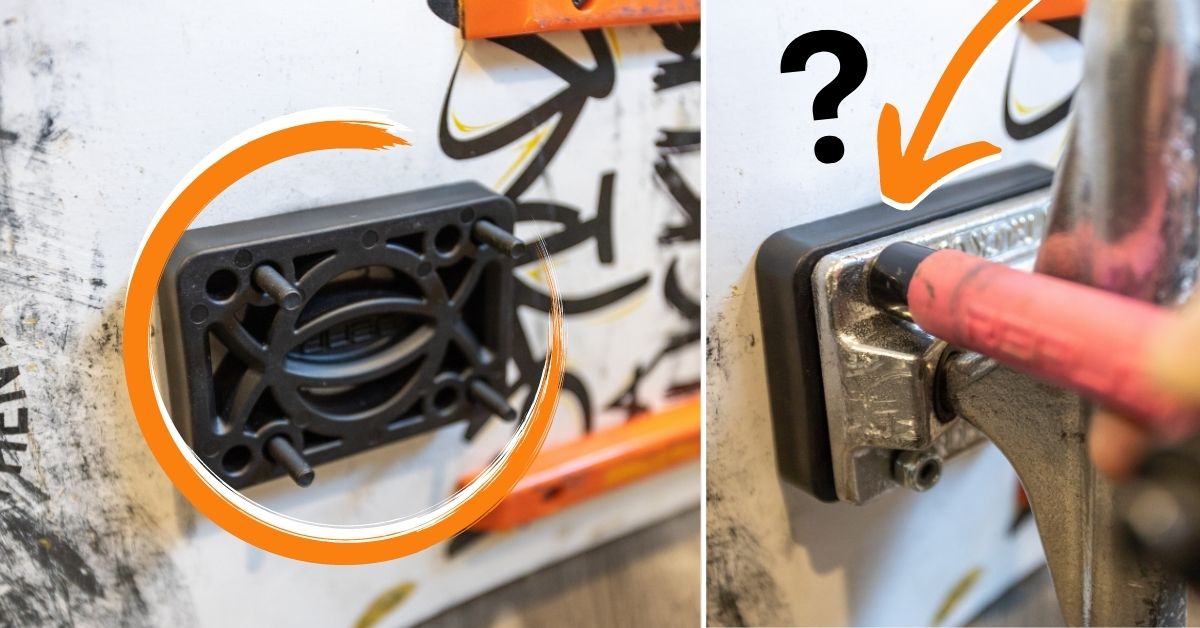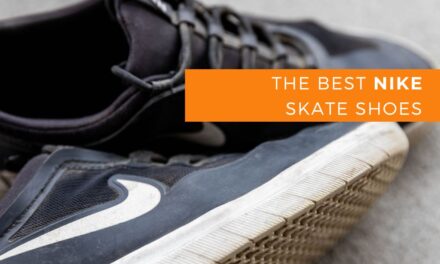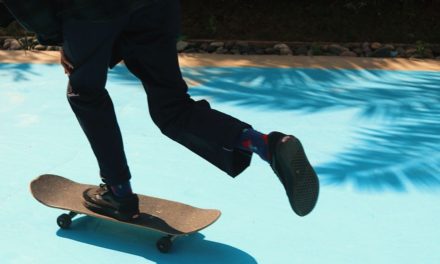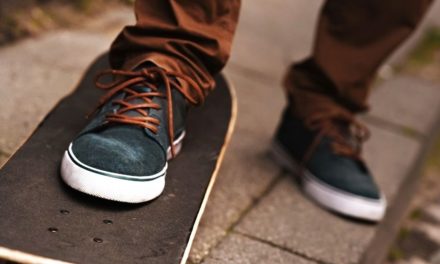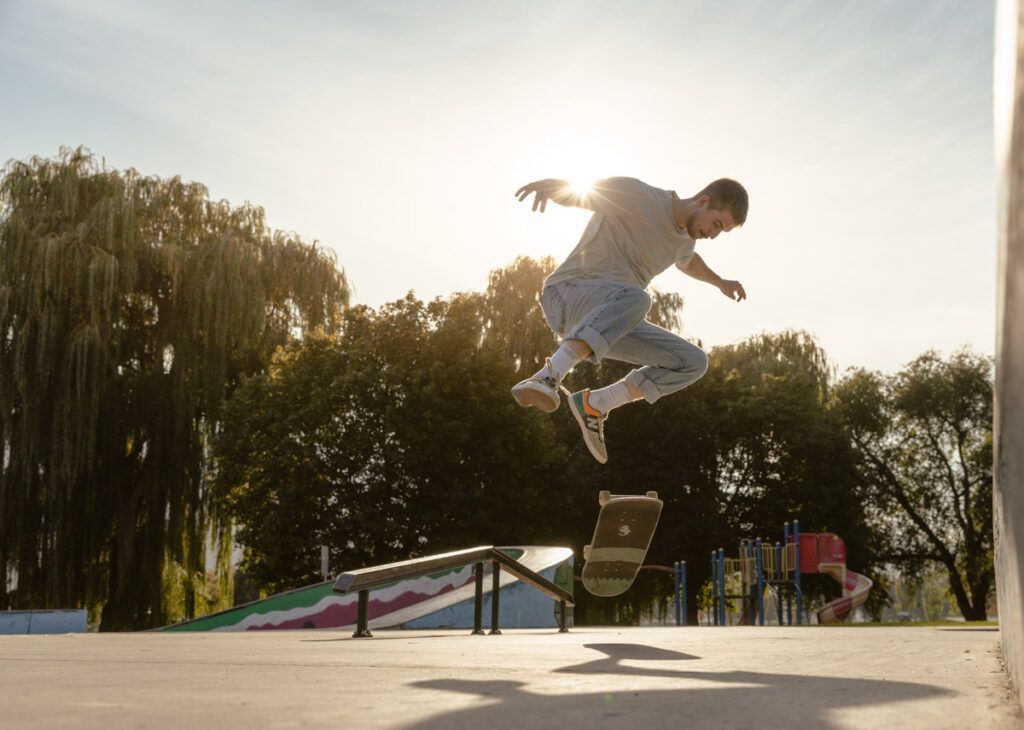If you ask any skater about riser pads, you’re likely to get some mixed reviews. Some people make fun of street setups with risers, while others rock a 1/4″ riser at all times. When I first started skating I always thought riser pads were a bit goofy, but it wasn’t until I started getting constant wheel bite and even noticing pressure cracks in my deck that my opinions changed.
Riser pads can be a really important piece to your skateboard setup, but they aren’t suited to everyone. Factors like the type of skating you do, the size of wheel you ride, or even the ground you skate on all play a role.
So whether you’re just curious why some skateboarders use riser pads, or you’re looking to install a set yourself, this post will share everything you need to know.
What’s The Point Of Riser Pads On A Skateboard?
Skateboard riser pads are plastic blocks that are placed between the baseplate of your trucks and the deck. Most commonly seen in 1/8″, 1/4″, and 1/2″ thicknesses for skateboarding, risers lift your skateboard deck, therefore creating more room for your wheels and reducing your chance of wheel bite.
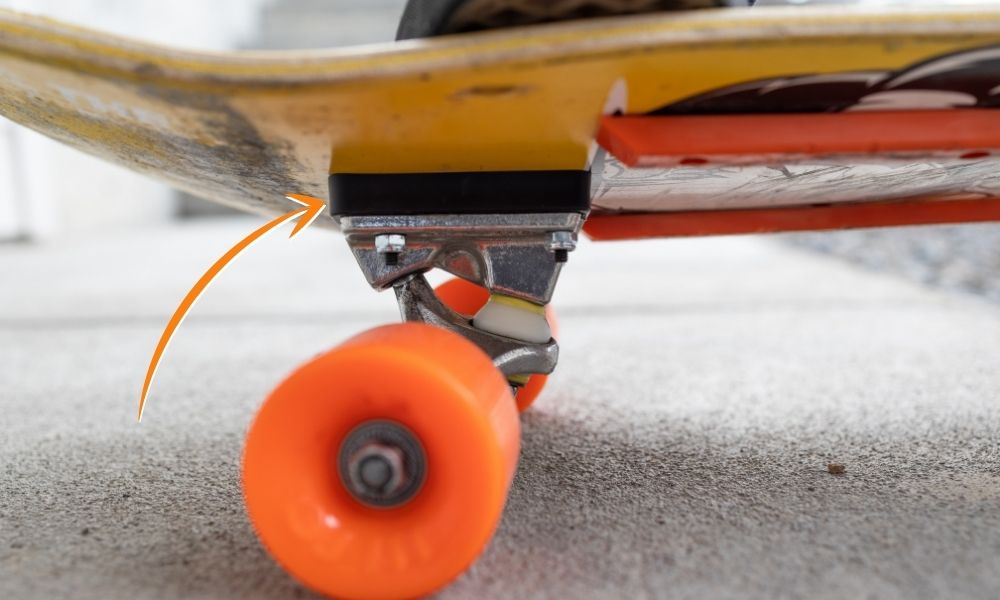
Now if you’re not sure what wheel bite is, it’s when your skateboard deck and wheels make contact. With enough weight on your deck, this contact will stop your wheel from rolling and cause you to lose balance or even get launched off your deck at higher speeds.
No matter how you look at it, wheel bite sucks.
Wheel bite is more common with larger wheels since they take up more space between the ground and your deck. That’s why riser pads are typically only used on skateboards that have 55mm wheels or larger.
By lifting your skateboard deck up (based on the thickness of the riser), you get more room for a larger wheel diameter with a reduced risk of your deck and wheel making contact.
Although wheel bite prevention is the main reason to use riser pads on a skateboard, they also prevent pressure cracks in your deck too.
When your skateboard deck absorbs a lot of big impacts (think jumping down stairs and large drops), this pressure gets transferred through the wheels, into the trucks, and ultimately ends up in your deck. In particular, this pressure tends to focus around the hardware, where pressure cracks are most common.
These cracks are usually visible as thin lines stretching out from the bolts on your skateboard and can ultimately weaken the overall strength of your deck.
With the help of riser pads, they absorb some of the impacts and disperse the energy over a larger surface area. There are also shock pads for this type of thing as well, but I’ll break that down a little more later on. For now, let’s take a look at the different types of riser pads you can buy.
Types Of Riser Pads
– Standard Riser Pads
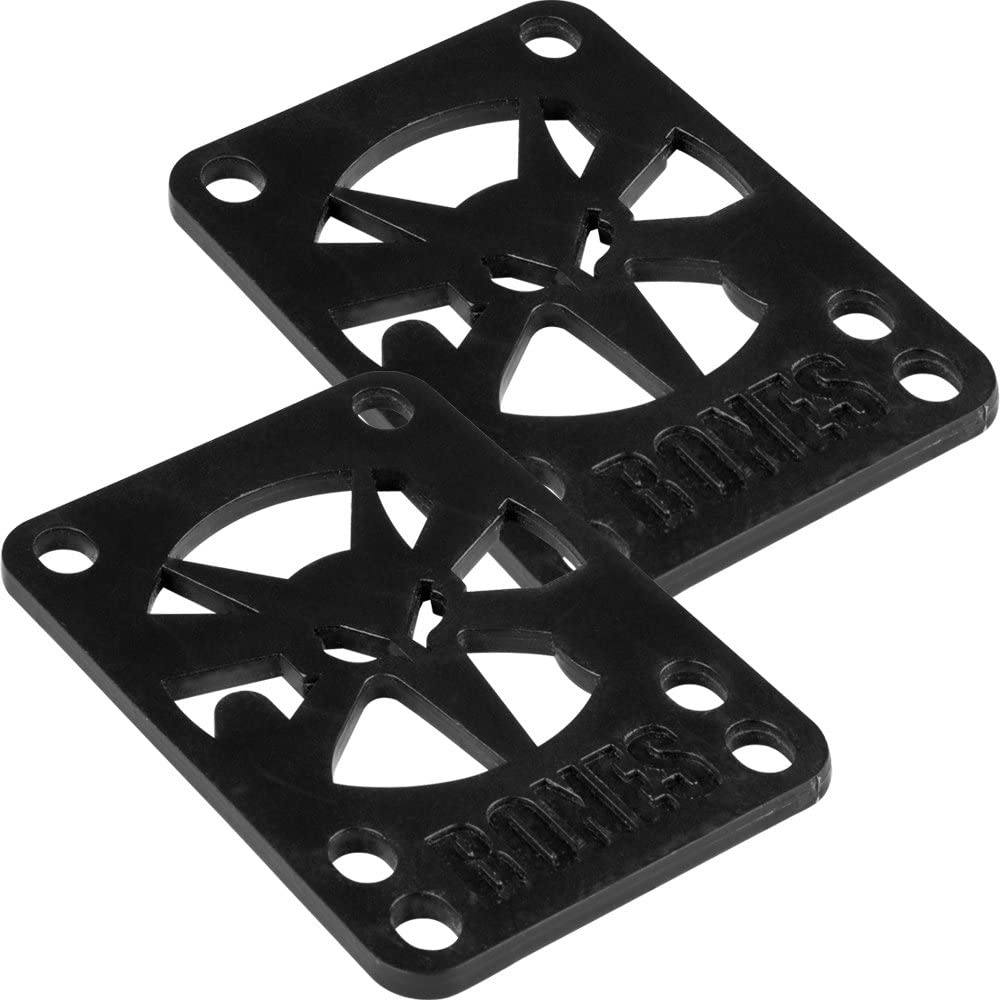
The first type of riser pad is the most common one, which is a flat rectangular block made of plastic. This type of riser is used primarily for creating more clearance between your deck and a larger wheel. They come in 1/8″, 1/4″, and 1/2″ sizes, with even larger sizes available that are typically only used for longboards.
– Angled Riser Pads
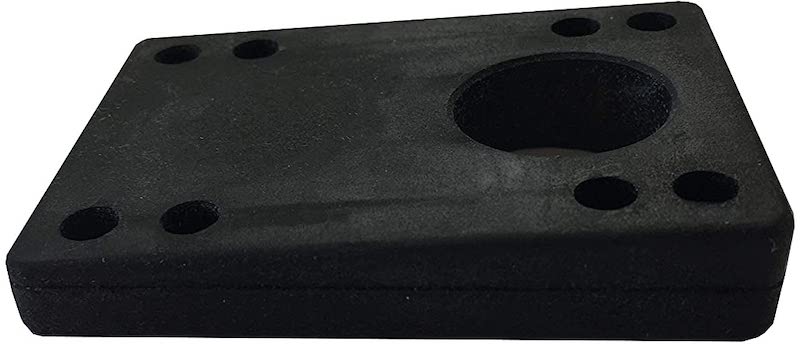
Angled or wedge riser pads are not typically used for regular skateboarding, but instead for cruising or longboards. These riser pads are thicker on one side so you can change the angle of your trucks. Depending on how you orient the risers, you can improve the turning radius and responsiveness of your board. This isn’t something that’s useful for street skating or at the skatepark but can be fun when cruising around town.
– Shock Pads

Unlike a standard riser pad, shock pads are thinner (around 1/8″) and made of rubber rather than plastic. The purpose of shock pads is to dampen vibrations coming from your trucks to create an overall smoother ride. Although softer wheels play a big role in how smooth your skateboard is on rough roads, shock pads can help reduce this vibration even further.
Riser Pads Vs Shock Pads
Although riser pads do help prevent pressure cracks to a certain extent, shock pads do a much better job at absorbing energy simply because they are rubber rather than plastic. If you’re planning to use a riser pad only to prevent pressure cracks, a shock pad would be a better solution.
With that said, shock pads are limited in how much they lift your board. Since they’re only 1/8″ thick, they don’t give a larger wheel that much extra room. For any wheel above 57mm, a shock pad won’t be enough to prevent wheel bite and you should instead opt for a standard riser pad.
Ultimately riser pads are meant primarily for lifting your board and creating clearance for larger wheels while shock pads are meant for dampening vibrations.
It is possible to mount both a shock pad and riser pad together, however, I’d only suggest doing this if you’re building a cruiser deck, rather than a board you’ll do tricks with.
Does Your Skateboard Need A Riser Pad?

Sometimes it’s hard to know whether or not you need a riser pad, and if you do, knowing which size to get can be difficult. So to make life easy, here’s a breakdown:
| Wheel Size | Suggested Riser Size | Suggested Hardware Length |
|---|---|---|
| 50mm – 54mm | No riser needed | 1″ hardware |
| 55mm – 58mm | 1/8″ riser | 1 1/4″ hardware |
| 58mm – 62mm | 1/4″ riser | 1 1/4″ hardware |
| 62mm – 68mm | 1/2″ riser | 1 1/2″ hardware |
Any wheel size above 68mm starts to get iffy and hard to fit on your skateboard. To give yourself enough space to turn your board without wheel bite, 68mm would be the upper limit to go with for wheel diameter.
When you’re skating a smaller wheel 54mm and below, a riser pad isn’t necessary since there’s already enough space for the wheels. I’ve even skated 55mm wheels without a riser pad and didn’t have an issue, however getting a 1/8″ riser for 55mm will give you some peace of mind for avoiding wheel bite.
How Riser Pads Can Improve Your Ollie Height
An interesting point about riser pads is that they actually can marginally improve the height of your ollie by creating more space between the ground and your tail. This creates more room for your tail to accelerate when you pop, which in turn increases the force of your pop along with the angle of your board.
Both of these factors together help to make your ollie higher, similar to why you can ollie higher out of a bank than on flat ground.
In this video by Ride Channel, they give a really good visualization of why this works. They use a 1/4″ riser pad which steepens the pop angle of the board from 35.5° to 37.2° and creates a 5% increase in ollie height for the skater in the video.
Although larger wheels can also improve the pop angle of your board, they are a lot heavier than a riser. That added weight ultimately limits the height of your ollie despite having a steeper pop angle.
Can You Still Do Tricks With Riser Pads?
When you first install a set of riser pads, the first thing you’ll notice is the higher center of gravity. This can make you feel a bit wobbly and off-balance, and make the first few tricks you do feel sketchy. Luckily with some getting used to, you can do all of the same tricks with or without a riser pad.
With that said, trying to do tricks with a 1/2″ riser is noticeably more awkward than with a 1/8″ riser. That’s why for street skating or riding at the skatepark, I wouldn’t suggest using anything larger than a 1/4″ riser. Anything past 1/4″ would only be needed if you were skating wheels 58mm and above, which are far too bulky and heavy for doing tricks enjoyably anyways.
If you’re more focused on doing tricks, consider going with a smaller wheel that doesn’t need a riser pad. I share all my favorite wheels for tricks and street skating in this guide.
But if you’re building a more cruiser-style board, you can still do just about any trick you want even with risers installed.
So Are Riser Pads Worth It?
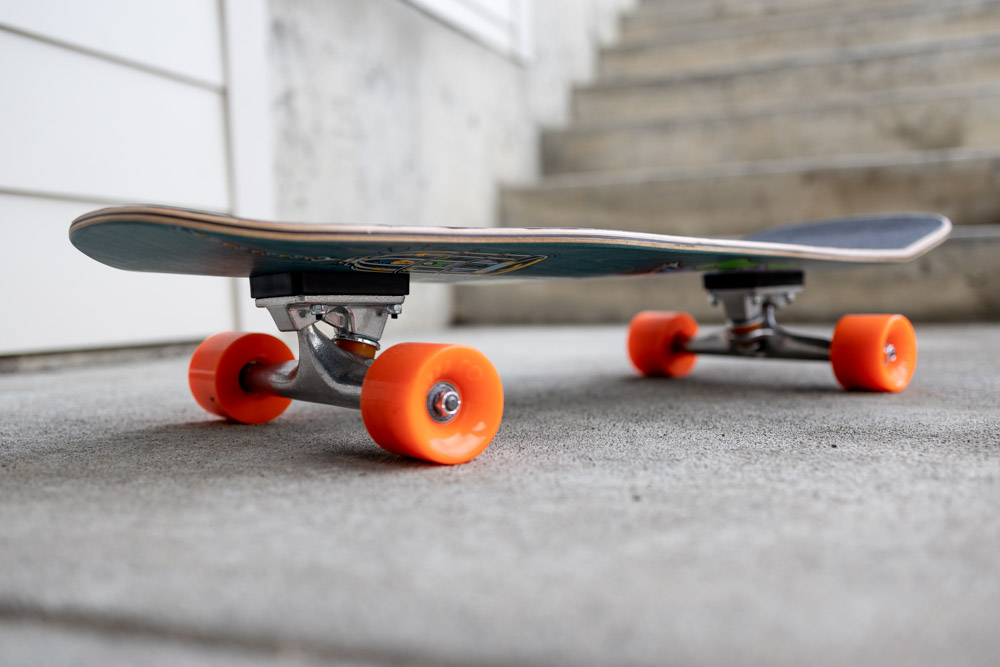
Riser pads are something you only need to install if you’re skating on larger wheels. If you have smaller wheels in the 50mm – 54mm range, there’s no need to install risers and it’s definitely not worth doing. However, if you’re skating 55mm+ wheels, getting riser pads will help avoid wheel bite and keep you rolling smoothly.
Now if you were considering a riser simply for the extra protection against pressure cracks, you should instead go with shock pads since those are far better at dampening vibrations. Plus they’re hardly noticeable to skate on, even when you’re skating ledges, rails drops, or flat ground.
Although you can’t really go wrong with any riser pad, I really like the Bones 1/8″ risers, the Independent 1/4″ Risers, or the Pig 1/2″ Risers.
Just remember to get 1 1/4″ hardware for 1/8″ and 1/4″ riser pads, or 1 1/2″ hardware for 1/2″ risers!
Happy Shredding!
Brendan 🙂

